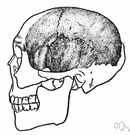temporalis muscle
Also found in: Thesaurus, Medical, Encyclopedia, Wikipedia.
ThesaurusAntonymsRelated WordsSynonymsLegend:
Switch to new thesaurus
| Noun | 1. |  temporalis muscle - muscle extending from the temporal fossa to the coronoid process of the mandible; acts to raise the mandible and close the jaws temporalis muscle - muscle extending from the temporal fossa to the coronoid process of the mandible; acts to raise the mandible and close the jawsskeletal muscle, striated muscle - a muscle that is connected at either or both ends to a bone and so move parts of the skeleton; a muscle that is characterized by transverse stripes |
Based on WordNet 3.0, Farlex clipart collection. © 2003-2012 Princeton University, Farlex Inc.